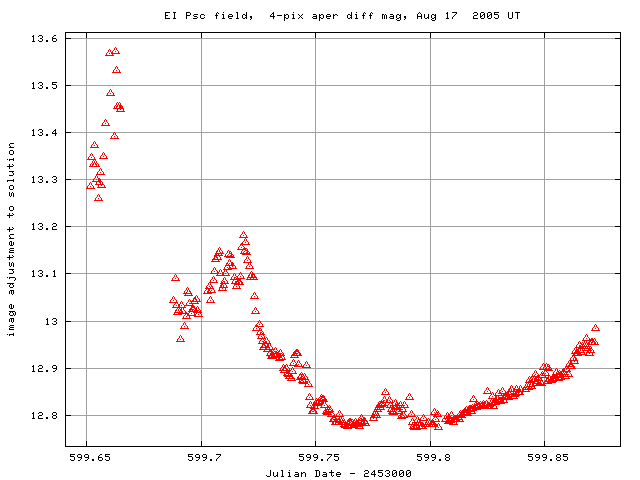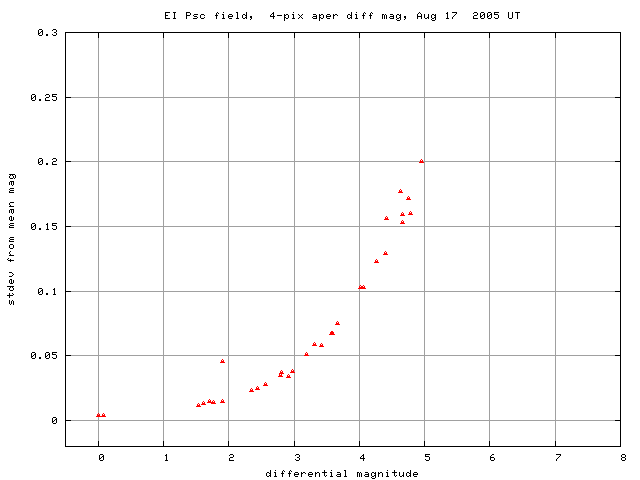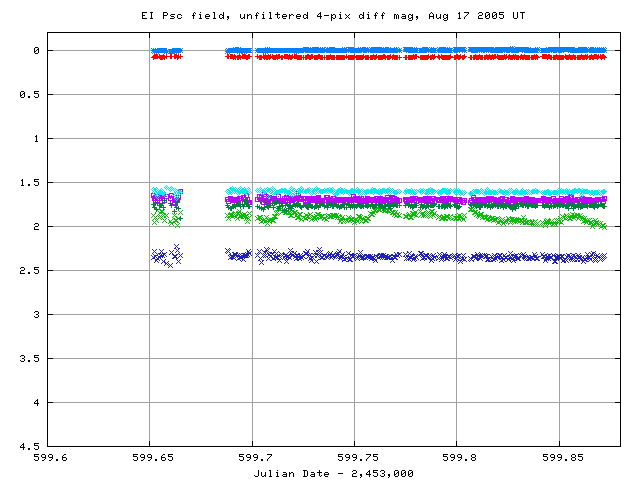
You can see that one bunch of thin clouds passed over the field around 599.78 -- you'll notice an increased scatter in the measurements at that time in the light curves below.
On the night of Aug 16/17, 2005 EDT, RIT student George Privon and I used the RIT Observatory's 12-inch Meade telescope and SBIG ST8 CCD camera to monitor the cataclysmic variable star EI Psc (also known as 1RXS J232953.9+062814) as it was near the peak of its outburst. We are acting on behalf of the Center for Backyard Astrophysics, VSNET, and all others who study these very interesting variable stars.
The plan:
Notes from the night

You can see that one bunch of thin clouds passed over the field around 599.78 -- you'll notice an increased scatter in the measurements at that time in the light curves below.
You can read about EI Psc in these articles:
The stars marked "A" and "B" were used as comparisons in the 2001 superoutburst, according to the Uemura et al. papers. Here is the rather poor information I can find about them:
USNO B1.0 mags
star GSC_1.2_ID USNO B1.0 ID RA (J2000) Dec B R
----------------------------------------------------------------------------
A 0591.1689 0964-0601121 23:30:02.7 +06:24:37 13.64? 11.83?
B 0584.366 0963-0598647 23:29:49.9 +06:22:11 12.4 12.85
----------------------------------------------------------------------------
I have used star "B" to set the zeropoint of my unfiltered measurements. I create a pseudo "V-ish" magnitude by the simple calculation (B+R)/2 based on the USNO B1.0 magnitudes, and end up with "V-band" mag = 12.63.
Yes, I know now that there is a good measurement of V = 12.2 for star "A", so that my differential measurements have a systematic offset of about +0.5 magnitudes. However, I will continue to use this (incorrect) zero-point for my unfiltered measurements for internal consistency.
MWR 8/17/2005
I measured the instrumental magnitude of each star with aperture photometry, using a radius of 4 pixels = 7.5 arcseconds and sky defined by an annulus around each star. Following the procedures outlined by Kent Honeycutt's article on inhomogeneous ensemble photometry, I used all stars available in each image to define a reference frame, and measured each star against this frame.
Below is a graph of the scatter in differential magnitude versus magnitude.

The two brightest stars -- which you can see between HD 221248 and star "A" in the chart above -- are both saturated in our 30-second images. The outlier at differential mag approx 2.0 is EI Psc. The formal scatter for the brightest unsaturated stars, "A" and "B", is about 0.004 mag.
Light curves for selected stars in the field are shown below. EI Psc, shown by light green crosses near the middle, is clearly variable.

Here's a closeup of the variation in EI Psc itself, with the comparison stars "C" (in purple) and "D" (in aqua). The amplitude of the variations is smaller than it was a week ago: only about 0.1 mag peak-to-peak. Because the data is so noisy, I show also in black a version of the measurements smoothed with a uniform boxcar of width 5 points.

It appears that EI Psc was fading slightly near the end of our run.
I've made a table of the measurements themselves, with three different flavors of time. The differential unfiltered magnitudes from the ensemble solution has been shifted so that star "B" in my chart, has value 12.63, matching a very rough guess at its V-band magnitude, based on B and R mags in the USNO B1.0 catalog.
Here's the start of the table.
# Measurements of EI Psc made at RIT Obs, Aug 17, 2005 UT, # made by Michael Richmond and George Privon. # All data taken with 12-inch LX-200 + no filter + SBIG ST-8 CCD # no focal reducer, so at native f/10 # Each exposure 30 seconds long; tabulated times are midexposure # and accurate only to +/- 1 second. # 'mag' is a differential magnitude based on ensemble photometry # which has been shifted so USNOB1.0 0963-0598647 has mag=12.63 # (a rough guess = (B+R)/2 and the USNO B1.0 magnitudes). # # UT day JD-2,450,000 HJD-2,450,000 mag uncert Aug17.15182 3599.65182 3599.65675 14.511 0.028 Aug17.15236 3599.65236 3599.65729 14.586 0.027 Aug17.15291 3599.65291 3599.65784 14.531 0.032
Last modified 8/17/2005 by MWR.